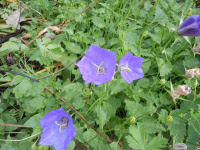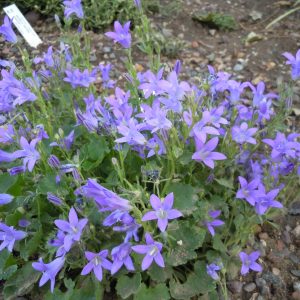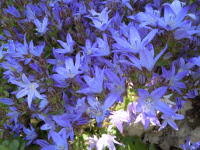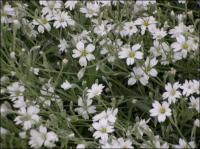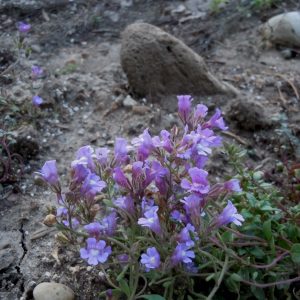Alpine, Rock, Miniature, Bonsai and Railroad Gardens
Showing 25–32 of 92 results
-
Bletilla striata syn. B. hyacinthina Chinese ground orchid Z 5-9
Racemes of pinkish-purple flowers on scapes above dark green, upright, lance-shaped leaves, April-May
OUT OF STOCK
Racemes of pinkish-purple flowers on scapes above dark green, upright, lance-shaped leaves, April-May
Size: 12-18” x 12”
Care: Part shade in moist, well-drained soil.
Native: China, Japan
Wildlife Value: Attracts bees, butterflies and hummingbirds. Deer & Rabbit resistant.
Awards: Royal Horticultural Society Award of Garden MeritProtect with thick winter mulch, may not reliably survive Zone 5 winters.
Spreads slowly by rhizomes and seeds in optimal conditions.
‘Bletilla’ honors Louis Blet, a Spanish apothecary in Algeciras who also had a botanic garden at the end of the 18th century. Collected before 1784 by Thunberg. -
Campanula carpatica Tussock bellflower, Carpathian bellflower Z 3-8
In summer blue, violet or white bells
In summer blue, violet or white bells, excellent at front of border.
Size: 12” x 12-24”
Care: Sun moist well-drained soil, tolerant of Walnut toxicity
Native: Carpathian mountains in central Europe
Awards: England’s Royal Horticultural Society Award of Merit.Campanula is Latin meaning little bell. In 1629 Parkinson described campanulas as “cherished for the beautie of their flowers…” Young roots were eaten in “sallets.” Introduced to European gardens from the Carpathian Mountains in 1774. Sold by McMahon’s Philadelphia nursery in the early 1800’s. Probably cultivated by Jefferson at Monticello.
-
Campanula portenschlagiana Dalmatian bellflower Z 4-8
Purple, upfacing bells for months in mid to late summer
OUT OF STOCK
Purple, upfacing bells for months in mid to late summer
Size: 4-6” x 20”
Care: full sun-part shade in moist well-drained soil
Native: Northern Yugoslavia
Awards: England’s Royal Horticultural Society Award of Merit. Top rated for ornamental traits and landscape performance by the Chicago Botanic Garden & Elisabeth Carey Miller Botanical Garden Great Plant Pick.Campanula is Latin meaning “little bell.” This species named for one of its discoverers, Franz Edler von Portenschlag-Ledermayer (1772-1822). 1st described in Systema Vegetabilium 5: 93 in 1819
-
Campanula poscharskyana Adriatic bellflower Z 4-8
Riot of lilac colored star-shaped blooms May - June
Riot of lilac colored star-shaped blooms May – June
Size: 6" X 24" spreading
Care: Sun to part shade in moist well-drained soil.
Native: Mountains of Eastern Europe
Awards: Top rated by the Chicago Botanic Garden. Elisabeth Carey Miller Botanical Garden Great Plant PickCampanula is Latin meaning “little bell.” Collected before 1822. Named for 19th century German plantsman, Gustav Poscharsky.
-
Campanula rotundifolia Harebell, Bluebell of Scotland Z 3-8
Its delicate appearance conceals its hardy constitution. Dainty bluish-lilac bells to 12” stems on bushy round ground-hugging foliage. Blooms from June to October. Perfect for rock gardens and borders.
Its delicate appearance conceals its hardy constitution. Dainty bluish-lilac bells to 12” stems on bushy round ground-hugging foliage. Blooms from June to October. Perfect for rock gardens and borders.
Size: 9-12" x 12"
Care: Sun to part shade in moist well-drained soil
Native: Europe, Siberia and North America, Wisconsin native
Wildlife Value: Walnut tolerantLakota ate the leaves raw and cooked and made an infusion of the roots to remedy earaches. Sir Walter Scott immortalized the Bluebell of Scotland in Lady of the Lake. Also a subject of Emily Dickinson’s poetry.
-
Centaurium scilloides Carpet tulip, Perennial centaury Z 5-9
Sweetest plant ever - tiny pink tulip-like flowers in constant bloom mid-summer to frost, close at night and open in daytime
OUT OF STOCK
Sweetest plant ever – tiny pink tulip-like flowers in constant bloom mid-summer to frost, close at night and open in daytime
Size: 2” x 4”
Care: sun to part shade in moist to moist well-drained soil
Native: Atlantic Ocean coasts of Europe, AzoresNamed by Carl Linnaeas the Younger in the supplement to his father’s legendary book Species Plantarum, 1782
-
Cerastium biebersteinii Mouse ear Z 4-7
White felt-like foliage, covered with white flowers
White felt-like foliage, covered with white flowers in spring. Makes a wonderful groundcover.
Size: 6" x spreading
Care: Sun in well-drained soil
Native: TauriaCerastium is from the Greek keras meaning horn because of the shape of the seed capsule. Six inch tall, spreading, small chalky-velvet leaves. Rarely offered but should be. Used as a groundcover for its frosted, felt-like foliage under tropical plants in Victorian gardens. American gardens since 1860.
-
Chaenorhinum glareosum Dwarf snapdragon Z 5-9
Rare plant. Spires of tiny purple to blue trumpets with yellow throats spring, summer & fall. Love this itsy plant.
Rare plant. Spires of tiny purple to blue trumpets with yellow throats spring, summer & fall. Love this itsy plant.
Size: 4” x 9-12” semi-trailing cushion
Care: sun to part shade in well-drained soil
Native: Spain
Wildlife Value: Attracts bees, butterflies and birds.1st described in 1838. Chaenorhinum means “honey lotus” in Greek.


